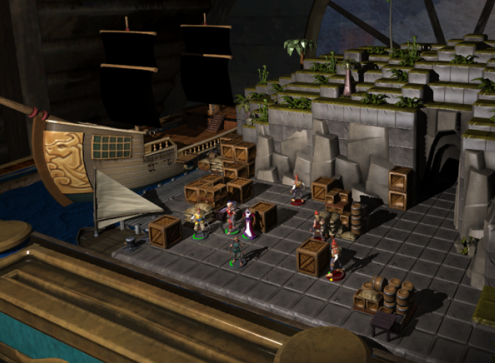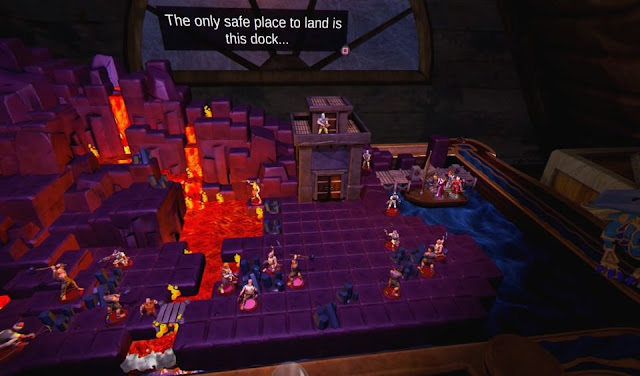Review by Matt S.
Going way, way back into the history of video game RPGs, the original goal of developers was to take the pen and paper experiences that so many people loved through the 70’s and 80’s (most notably through Dungeons & Dragons), and then give them the chance to have that experience without needing to get a group of friends together for an evening. It took the advent of VR to finally realise that early goal. I’ve been playing Dungeons & Dragons since I was five. That’s 30-odd years now. I love it to this day as much as I did when I first played. That alone should tell you how much I love Tin Man Games’ Table of Tales.
This is not to say that video game RPGs have been an inferior experience. Rather, it’s to acknowledge that whatever the intent was with those first RPGs, the genre has spun in its own direction and now offers something entirely different, using the strengths of the video game medium to deliver worlds and experiences that pen and paper RPGs cannot. With that being said, as much as I love my Final Fantasies and Dragon Ages, it has been so exciting to play something that sticks to those lofty goals from way back when.
One area that video games have never been able to effectively deliver is in giving players a sense of the tactility of a physical game. The experience of staring down at a table, with pieces and dice arrayed around, and being able to touch the action. It can be messy – you throw dice at the wrong angle and pieces go flying. In the middle of an intense combat, moving your piece, surrounded by enemies, would bump them all around. In many ways it is a primitive way to play, but imperfect as it is means that it is also a deeply human way to play. That is something that the distancing effect of a screen, coupled with the necessary precision of video game development, has never been able to properly recreate.
This is the perfect VR experience. It’s like Hero Quest ^_^ #PS4 sharehttps://t.co/v8Xqbm4g2i pic.twitter.com/np8bDwmd8u— Digisexual for Hatsune Miku 🇯🇵 (@DigitallyDownld) April 19, 2019
With VR, however, that inhibition is thrown away, and Tin Man Games has been able to place you directly and physically into the action. Table of Tales’ playing field is largely static. Scenery pops up and is cleared away as the setting changes, but that static design is deliberate, to make it look like a series of boards arrayed over a table top, and the pieces are, just like physical playing pieces, inanimate. With such a “limited” set up, the development team at Tin Man Games has not been able to use facial expressions or movement to tell its story. Further, as habitual VR players all know, reading text for long periods isn’t ideal with the googles on either. Because of that, the team has not been able to rely on the same fallbacks that many RPGs have over years – neither cinematic cut scenes nor large blocks of text would have worked here.
Instead, Tin Man Games has simply given us a proper, bona fide dungeon master. A gorgeously-rendered jeweled bird hops around the board as you play Table of Tales, relaying the story – complete with the performative acting of different voices to represent different characters – and by providing a running commentary of the combat and dramatic events, it paints vivid pictures of exciting, heroic action to go with the static boards. It is a spot-on recreation of the best pen-and-paper RPG experiences and dungeon master performances. And it’s impossible not to be delighted by it if you have had any experience with pen-and-paper games in the past.
Mechanically, Table of Tales is quite simple. Where Dungeons & Dragons gives you pages of statistics to manage your character with, that, too would have been too much reading and busywork for a VR experience. The solution Tin Man Games has come up with is delightful. While I’m stretching deep into 90’s nostalgia to say this (sorry, younger readers), anyone who remembers Hero Quest will have a good sense of the way character development works in Table of Tales. All character statistics are distilled down to what can fit on a single card. When characters level up, they get a couple of extra abilities to play with, and that’s it. It might initially seem simplistic, but what’s ultimately important with this kind of game (and certainly applied to Hero Quest) is that each character has their own unique play style (they do), and that the variety of combat scenarios and non-combat skill tests is nicely varied so that everyone gets their moment to shine (it is). You can learn to play Table of Tales in about five minutes, irrespective of your experience with pen-and-paper RPGs or video game RPGs. Actually completing the game is a stiffer challenge, however, thanks to the depth that Tin Man Games has managed to squeeze out of its systems.
The one area where Table of Tales hasn’t perfectly emulated the pen-and-paper experience is the inability for players to play an active participation role in the storytelling. I don’t think there has been a single time I’ve played Dungeons & Dragons where the players have failed to make decisions that completely derail the careful plans of the DM. Perhaps the party don’t go hunting for the magical artefact that they’re meant to. Perhaps they decide to form an alliance with the villain at the base of a dungeon. Perhaps they “accidentally” kill an allied prince and render themselves enemies of the state. One of the great things about pen-and-paper RPGs is that there’s a storytelling loop in the performance where the actors (the players) have an equal role in writing the stories as the playwright (DM) does. The infinite number of decisions that a party of people might make, and the capacity for a DM to compensate to keep the story cohesive is a big part of the fun of pen-and-paper gaming. That is, of course, impossible for a video game.
Table of Tales offers yet another elegant solution, familiar to anyone who has played a Tin Man Games title in the past. The narrative decision making is structured as a gamebook, where players frequently come up against a binary (or sometimes, three or four-pronged) decision to make. There’s no right or wrong in these decisions, but each offers the player benefits and negatives, and slightly adjusts the narrative flow that they’ll subsequently experience. The good news is that those decisions are often intriguing enough to justify additional play throughs, further extending the life of a game that, like a good Dungeons & Dragons adventure, is already eminently replayable.
Tin Man Games could, in theory, make versions of Table of Tales that don’t utilise VR, for release on Nintendo Switch, the iPad and other tablets, and to give people with PCs and consoles, but no VR, a chance to play the game. Doing so would make Table of Tales look and feel very much like the equally-excellent Warlock of Firetop Mountain, which has been doing the rounds for some time now, so it would still work, as such. But that (currently) hypothetical release would also lack the sense of presence that really elevates the aesthetic and experience of Table of Tales. If you can, you owe it to yourself to play this in VR, regardless of what other versions might make arrive down the track.
Table of Tales offers a brilliantly modular opportunity to Tin Man Games. As long as it’s commercially successful (and I certainly hope it is), it’s easy to imagine the developer releasing additional adventures, chapters, and tales to this base package… much like how Dungeons & Dragons uses its core rulebooks to give you all the tools you need to play one heroic adventure after another, to the point where the world that the storyteller creates, and that players interact with, grows to become secondary homes of the imagination. That Tin Man Games has managed to take the newest of video game technologies to deliver something so perfectly nostalgic that it predates video games entirely. Somehow, that also makes Table of Tales the most impressive application of VR that doesn’t let me get up on stage with Hatsune Miku and dance with her.
– Matt S.
Editor-in-Chief
Find me on Twitter: @digitallydownld
Please help keep DDNet running: Running an online publication isn’t cheap, and it’s highly time consuming. Please help me keep the site running and providing interviews, reviews, and features like this by supporting me on Patreon. Even $1/ month would be a hugely appreciated vote of confidence in the kind of work we’re doing. Please click here to be taken to my Patreon, and thank you for reading and your support!










